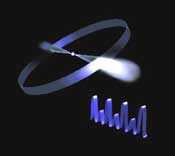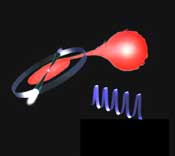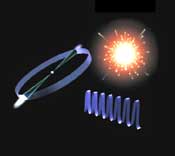Pulsar Basics
In the collapsing iron core of a massive dying star, gravity overwhelms the resistance of the atomic nuclei, and protons and electrons combine to make neutrons. The process releases a blast of energy that blows away the remaining stellar material in a supernova explosion. What's left is an object with a mass of about 1.4 times that of our Sun compressed into a sphere about 10 miles in diameter. Because of its vastly reduced size, the neutron star spins more than  a million times faster than its parent star, creating a strong magnetic field and emitting energy along its magnetic axis. Observers on Earth see this emitted energy as a pulse because the star's magnetic axis does not coincide with its rotational axis (right). Rather, the beams rotate as the pulsar spins, so we only see it if it crosses our line of sight. Sometimes weaker pulses alternate with stronger ones (graph at right), indicating that the pulsar's two beams may be of different intensities. a million times faster than its parent star, creating a strong magnetic field and emitting energy along its magnetic axis. Observers on Earth see this emitted energy as a pulse because the star's magnetic axis does not coincide with its rotational axis (right). Rather, the beams rotate as the pulsar spins, so we only see it if it crosses our line of sight. Sometimes weaker pulses alternate with stronger ones (graph at right), indicating that the pulsar's two beams may be of different intensities. |   | Ticking Every Millisecond Of the more than 1,000 radio pulsars detected so far, several dozen have been found that spin hundreds of times per second. Astronomers theorize that in order for the neutron star to be "spun up" to such incredible speeds, it must be part of a binary pair. Depicted here is one theory for how a millisecond pulsar comes to be. Once the first star has exploded as a supernova, the resulting neutron star begins to draw matter from its partner (above). The companion becomes a red giant (above right) as the pulsar continues to draw material, speeding up its "accretion-powered" rotation rate as indicated in the graph.  In the final phase of this sequence, the companion star goes supernova, leaving a neutron star whose beacons are so oriented as to be invisible to Earth. We then see only the original pulsar, spinning at a furious rate. In the final phase of this sequence, the companion star goes supernova, leaving a neutron star whose beacons are so oriented as to be invisible to Earth. We then see only the original pulsar, spinning at a furious rate. |
black-hole densities. For instance, a clump with as much mass as an asteroid would form a pinhead-sized black hole. This remains in the realm of theory; we have seen no evidence for such objects. But if they exist, mini black holes could zip through Earth upon occasion. The resulting shock wave in the atmosphere might produce an effect similar to the impact of a small asteroid. A few scientists speculated that the 1908 tree-flattening blast at Tunguska, Siberia  , was just such an event. However, further studies suggested that the guilty party was a tiny comet or a rocky asteroid , was just such an event. However, further studies suggested that the guilty party was a tiny comet or a rocky asteroid  that vaporized in the atmosphere. that vaporized in the atmosphere.
Mini black holes would behave in other odd ways. If one wandered through the Sun, it could become trapped by the Sun's gravity and oscillate back and forth through the star for millions of years. Eventually, calculations show, it would stop at the core of the Sun. The Sun would barely care, since the hole's gravitational field would be intense only within a radius of a few feet. Even more strangely, the English physicist Stephen Hawking  has suggested that a black hole should evaporate over time via a quantum mechanical process now known as "Hawking radiation has suggested that a black hole should evaporate over time via a quantum mechanical process now known as "Hawking radiation  ." If so, the black hole would emit x-rays and gamma rays for billions of years at an ever-increasing rate. Ultimately, it would explode in a burst of pure energy. It's hard to imagine a more complete transformation: a chunk of the densest matter of all vanishing with a flash ." If so, the black hole would emit x-rays and gamma rays for billions of years at an ever-increasing rate. Ultimately, it would explode in a burst of pure energy. It's hard to imagine a more complete transformation: a chunk of the densest matter of all vanishing with a flash  into the void. into the void. |

